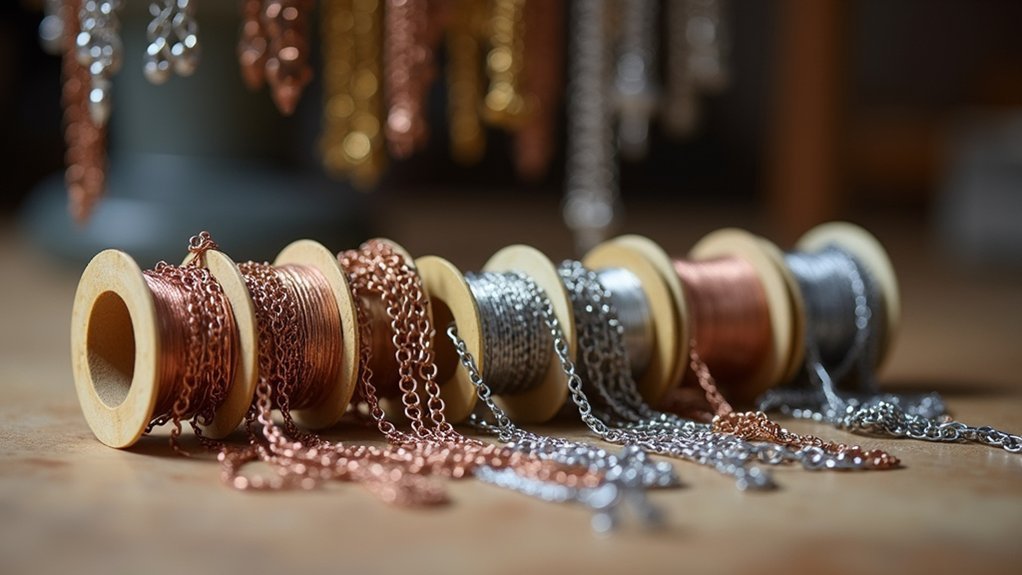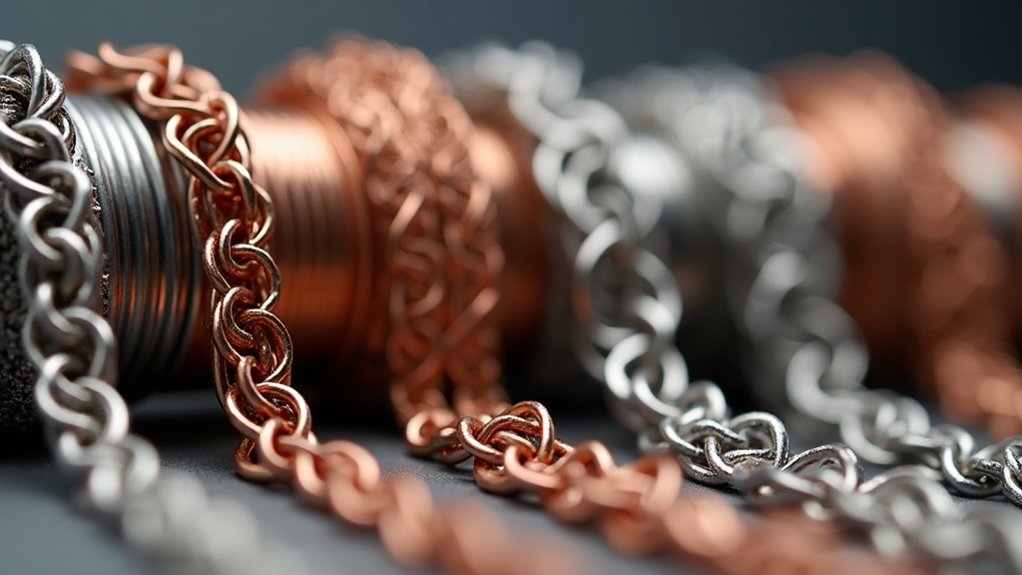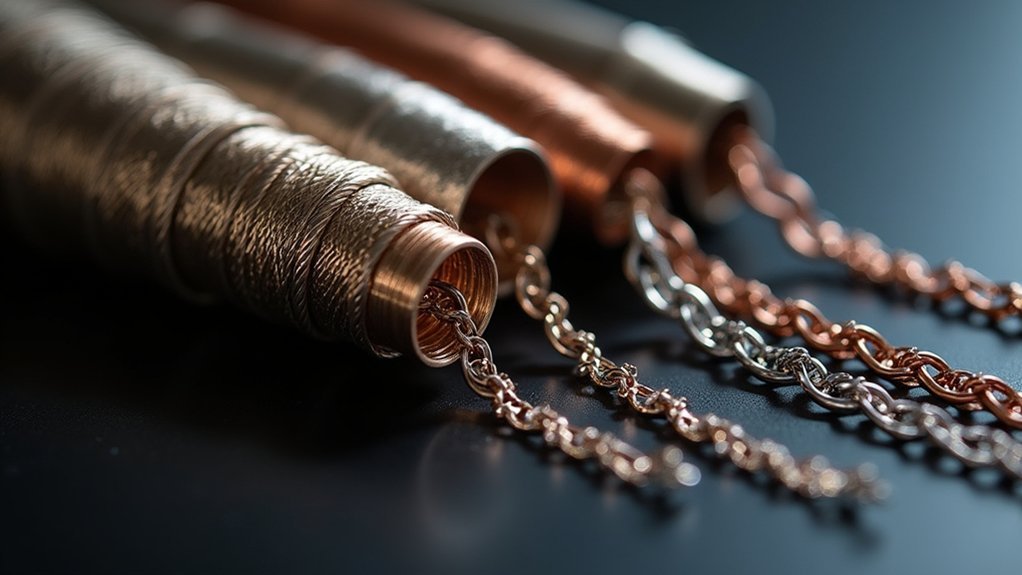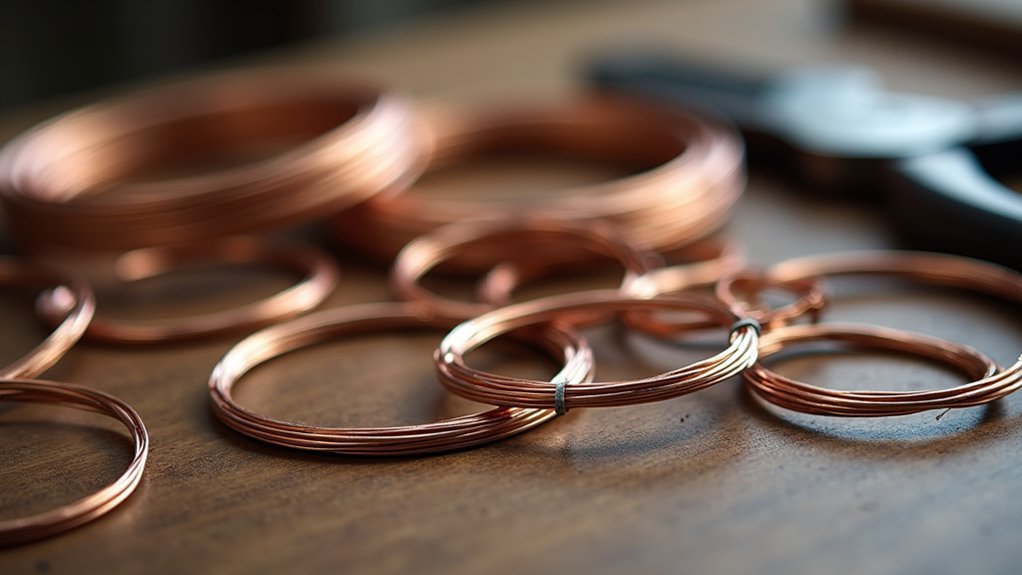You’ll want 10-14 gauge wire for heavy statement chains and chokers, 16-18 gauge for versatile everyday pieces that balance durability with workability, and 20-22 gauge for delicate lightweight chains with intricate details. Ultra-fine 24-28 gauge works best for Viking knit techniques and wrapped loops. Choose half-hard wire for the ideal balance between shape retention and bendability. Your chain’s intended use and design complexity should guide your final gauge selection for best results.
Understanding Wire Gauge Systems for Chain Making

When you’re starting your chain-making journey, understanding wire gauge systems becomes your foundation for creating successful pieces. The American Wire Gauge (AWG) system dominates North American jewelry making, where lower numbers mean thicker wire.
You’ll find that 18-gauge wire offers the perfect balance of strength and workability for most chain links, making it essential for developing your jewelry making skills.
Beyond gauge selection, you need to take into account flexibility and hardness properties. Dead soft wire bends easily but lacks structural integrity, while half-hard wire maintains shape better.
Wire hardness determines both workability and structural strength in your finished chain designs.
Thicker wire gauges like 16-gauge create substantial, durable chains for statement pieces, whereas 22-gauge works best with delicate, lightweight components.
Understanding these fundamentals guarantees you’ll choose appropriate materials for each specific chain project.
Heavy Gauge Wire (10-14 Gauge) for Statement Chains
When you’re crafting statement chains, heavy gauge wire between 10-14 gauge delivers the structural integrity you need for pieces that’ll withstand daily wear and maintain their shape over time.
You’ll need to invest in specialized heavy-duty tools like robust cutters and pliers since standard jewelry-making equipment won’t handle the thicker material effectively.
The bold, substantial appearance of heavy gauge wire creates striking visual impact that transforms simple chain designs into eye-catching statement pieces.
Structural Integrity Benefits
Three key advantages make heavy gauge wire your go-to choice for statement chains that’ll last. When you’re crafting jewelry that demands attention, structural integrity becomes paramount for both aesthetics and longevity.
Heavy gauge wire delivers unmatched durability. Your 10-gauge wire provides maximum strength for chokers and stiff bracelets, while 12-gauge wire balances robustness with workability for intricate designs. The 14-gauge wire offers versatility without sacrificing stability.
| Wire Gauge | Diameter (inches) | Best Applications |
|---|---|---|
| 10-gauge | 0.128 | Chokers, stiff bracelets |
| 12-gauge | 0.104 | Chain links, wire sculptures |
| 14-gauge | 0.080 | Heavy clasps, versatile links |
These structural integrity benefits guarantee your statement chains withstand daily wear while maintaining their striking appearance. In jewelry making, choosing appropriate gauge prevents breakage and preserves your craftsmanship investment.
Tool Requirements Considerations
Heavy-duty tools become non-negotiable when you’re working with 10-14 gauge wire for statement chains. You’ll need heavy gauge wire cutters and pliers that can handle the increased thickness without damaging your materials.
Round nose pliers are crucial for creating smooth loops and curves in thicker wire, while chain nose pliers provide the grip strength necessary for manipulating links securely. Quality flush cutters are essential for achieving clean cuts without jagged edges that could compromise your chain’s integrity.
These sturdy tools enable you to apply work hardening techniques effectively, strengthening your wire while maintaining shape. Investing in professional-grade equipment guarantees you can craft robust chains that withstand daily wear while maintaining their bold, structural appearance.
Design Aesthetic Impact
Bold architectural lines define the visual impact of heavy gauge wire chains, transforming simple jewelry into commanding statement pieces. When you choose 10-14 gauge wire, you’re selecting a design aesthetic that prioritizes bold presence over delicate subtlety.
The substantial thickness of heavy gauge wire creates dramatic shadows and catches light differently than finer alternatives, enhancing visual impact markedly. Your wire gauge selection directly influences the jewelry’s personality.
Ten gauge wire produces stiff, geometric forms perfect for modern chokers, while 12 gauge allows wire-sculpted details without sacrificing structural integrity. Fourteen gauge offers versatility across multiple jewelry styles while maintaining that coveted heavyweight feel.
The durability of heavy gauge wire supports larger beads and components, enabling you to create statement chains that demand attention and withstand daily wear.
Medium Gauge Wire (16-18 Gauge) for Versatile Chain Designs
When you’re looking to balance durability with design flexibility, medium gauge wire in 16 and 18 sizes becomes your go-to choice for handcrafted chains. These gauges offer superior versatility for creating jewelry pieces that withstand daily wear while maintaining refined aesthetics.
| Wire Gauge | Best Applications |
|---|---|
| 16-gauge (1.29mm) | Heavy chain links, sturdy clasps |
| 18-gauge (1.02mm) | Delicate components, intricate details |
You’ll find 16-gauge wire perfect for durable components requiring extra strength, while 18-gauge strikes an excellent balance between delicacy and durability. Both gauges retain their shape exceptionally well, making them outstanding for jump rings and connecting elements. The medium gauge wire allows easier manipulation than thicker options, enabling you to craft versatile designs without sacrificing structural integrity in your handcrafted chains.
Fine Gauge Wire (20-22 Gauge) for Delicate Chain Work

For artisans seeking to create ethereal, lightweight chains with intricate detailing, fine gauge wire in 20-22 sizes offers the perfect combination of workability and delicate strength.
You’ll find 20-gauge wire, measuring 0.032 inches in diameter, provides excellent durability while maintaining the lightweight quality essential for comfortable handcrafted chains. When you need even more intricate work, 22-gauge wire at 0.028 inches enables incredibly detailed patterns and smaller design elements.
This fine gauge wire excels in crafting jump rings, eye pins, and head pins—the fundamental building blocks of delicate chains.
You’ll appreciate how these gauges allow seamless incorporation of small beads and subtle embellishments without overwhelming your design’s refined aesthetic, making them indispensable for sophisticated jewelry work.
Ultra-Fine Gauge Wire (24-28 Gauge) for Intricate Chain Details
Ultra-fine gauge wire from 24 to 28 gauge takes delicate chain work to its most refined level, with diameters ranging from 0.0220 inches down to an impressively thin 0.0148 inches.
This ultra-fine gauge wire excels at creating intricate chain details through wire weaving, crocheting, and crafting flexible yet strong links for delicate designs.
You’ll find 24-gauge perfect for Viking knit and wrapped loop techniques, while 26-28 gauge handles finer projects and small-holed beads beautifully.
However, you must handle this wire carefully since it breaks easily when kinked.
Ultra-fine wire demands gentle handling and smooth movements to prevent kinking that leads to breaks and project frustration.
The payoff for your careful technique is substantial: you’ll create lightweight chains that bring elegant sophistication to your handcrafted jewelry while enabling detailed embellishments impossible with thicker gauges.
Wire Hardness Selection for Chain Durability

Although wire gauge determines the physical dimensions of your chain, wire hardness plays an equally critical role in determining how well your handcrafted chain will stand up to daily wear and handling.
| Wire Type | Best Use | Durability Factor |
|---|---|---|
| Dead Soft Wire | Intricate designs | Requires work hardening |
| Half-Hard Wire | Standard chains | Excellent shape retention |
| Full Hard Wire | Heavy-duty links | Maximum strength |
| Annealed Wire | Complex bending | Needs post-treatment |
| Work Hardened | Final assembly | Enhanced durability |
You’ll find that half-hard wire offers the perfect balance for most chain projects, maintaining shape while providing workability. Dead soft wire suits complex patterns but needs strengthening afterward. For maximum chain durability, choose thicker gauges like 16-18 gauge in half-hard temper. When wire becomes too stiff, annealing techniques can restore workability without compromising final strength.
Gauge Considerations for Different Chain Link Styles
When you’re planning your chain design, you’ll need to match wire gauge to your intended link style for best results.
Heavy link constructions demand thicker gauges like 16 or 18 to handle the structural demands and weight distribution effectively.
Delicate chain patterns require thinner options such as 20, 22, or even 24-gauge wire that won’t overpower intricate details while maintaining necessary flexibility.
Heavy Link Constructions
Heavy link constructions demand thicker wire gauges that can withstand the mechanical stress of substantial chain designs while maintaining their structural integrity over time.
For these demanding applications, you’ll want to start with 16-gauge wire as your minimum standard, providing essential strength without sacrificing workability. When creating robust chain links that need to support larger beads and components, 14-gauge wire delivers the perfect balance of durability and flexibility for your durable structure.
Consider 18-gauge wire for medium-heavy applications where you need versatility alongside strength.
For exceptional durability in statement pieces and bangle bracelets, 12-gauge wire offers unmatched structural support. You can also explore twisted or square 16-gauge wire for heavy link constructions that require both visual appeal and substantial strength.
Delicate Chain Patterns
While heavy constructions require substantial wire support, delicate chain patterns call for a completely different approach that prioritizes finesse and intricate detail work. You’ll find that selecting the right wire gauge becomes essential for achieving elegant, lightweight designs that maintain structural integrity.
| Wire Gauge | Diameter | Best Applications |
|---|---|---|
| 20-gauge | 0.032 inches | Balanced strength for intricate links |
| 22-gauge | 0.028 inches | Fine links with small gemstones |
| 24-gauge | 0.022 inches | Ultra-delicate weaving techniques |
For handcrafted chains emphasizing delicate chain patterns, 20-gauge wire offers ideal balance between workability and durability. When creating ultra-fine details, 22-gauge wire accommodates lightweight designs beautifully. Consider 24-gauge wire for intricate weaving, though handle carefully to prevent breaks during construction.
Wire Strength and Weight Factors in Chain Construction

Understanding how wire gauge affects both strength and weight is essential for creating chains that meet your specific design requirements.
Mastering wire gauge selection ensures your handcrafted chains achieve the perfect balance of durability and aesthetic appeal for any project.
When selecting wire gauge for handcrafted chains, you’ll find that 20-gauge (0.032 inches) offers an ideal balance between wire strength and manageability. For lightweight chains requiring intricate detailing, 22-gauge (0.028 inches) provides flexibility while maintaining adequate durability for everyday wear.
Thicker wires like 18-gauge (0.040 inches) greatly increase chain construction strength, making them ideal for heavy-duty applications experiencing frequent use. However, you’ll notice increased weight with these gauges.
The wire gauge directly impacts your final chain’s weight—thinner gauges create lighter pieces perfect for delicate designs or layering. Consider using half-hard wire in your chosen gauge to enhance durability and reduce kinking or breaking under stress.
Professional Tips for Gauge Selection Based on Chain Purpose
When selecting wire gauge for your handcrafted chains, you’ll achieve the best results by matching the gauge directly to your chain’s intended purpose and load requirements.
For delicate jewelry making projects featuring lightweight pendants or charms, 20-gauge wire provides the perfect balance of strength and flexibility for jump rings and links.
Step up to 18-gauge wire when crafting medium-weight chains that need additional durability for larger loops or clasps.
Heavy-duty handcrafted chains requiring structural integrity demand 16-gauge wire’s robust construction.
For intricate designs with fine details or small beads, 24-gauge wire excels at delicate weaving and wrapped loops.
Remember: thicker gauges suit statement pieces while thinner gauges create elegant, lightweight designs.
Frequently Asked Questions
What Gauge Wire for Chain Making?
You’ll want 20-gauge wire for most chain making projects since it’s sturdy yet flexible. Use 18-gauge for heavier chains or 22-gauge for delicate work with small components.
What Gauge Wire Is Best for Crafts?
You’ll find 20-gauge wire works best for most craft projects. It’s flexible enough for intricate work yet strong enough for durability. For delicate pieces, try 22-gauge, while heavier projects need 16-gauge wire.
Is 18 Gauge Wire Good for Jewelry?
You’ll find 18 gauge wire excellent for jewelry making. It’s strong enough for chains, clasps, and jump rings while remaining easy to manipulate. Its half-hard temper maintains shape after bending, perfect for durable components.
Should I Use 12 or 14 Gauge Wire?
Choose 12-gauge if you’re making heavy-duty pieces like bangles or need maximum durability. Go with 14-gauge for most jewelry projects since it’s easier to manipulate while still providing good strength.
In Summary
You’ll achieve stunning handcrafted chains by matching wire gauge to your design vision. Heavy gauges create bold statements, while fine wires enable delicate details. Don’t forget to take into account wire hardness and your chain’s intended use when selecting gauge. Remember that practice makes perfect—experiment with different gauges to understand how each affects your chain’s appearance and durability. Your gauge choices will ultimately define your chain’s character and functionality.





Leave a Reply